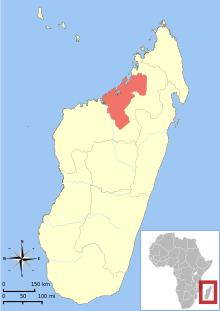Coquerel Sifaka
| Coquerel Sifaka | ||||||||||||
|---|---|---|---|---|---|---|---|---|---|---|---|---|

Coquerel sifaka ( Propithecus coquereli ) |
||||||||||||
| Systematics | ||||||||||||
|
||||||||||||
| Scientific name | ||||||||||||
| Propithecus coquereli | ||||||||||||
| ( A. Grandidier , 1867) |
The Coquerel Sifaka ( Propithecus coquereli ) is a species of primate from the Indri-like family within the lemurs . It is named in honor of the French naturalist Charles Coquerel . It was formerly considered a subspecies of the larval sifaka .
features
Coquerel sifakas reach a head body length of 42 to 50 centimeters, in addition there is the 50 to 60 centimeter long tail. Their weight is 3.5 to 4.3 kilograms, making them one of the smaller sifaka species . Their fur is soft and dense, their head, back and tail are white, and their upper arms, chest and thighs have conspicuous brown areas. The face, surrounded by a fringe of white hair, is hairless and colored dark gray or black, the black ears protrude from the fur, the eyes are yellow. As with all sifakas, the hind legs are significantly longer than the front legs.
distribution and habitat
Like all lemurs, Coquerel's sifakas are only found in Madagascar , they inhabit a relatively small area in the northwest of this island. Their distribution area extends from Befandriana Nord to the Betsiboka River . Their habitat are dry deciduous forests , sometimes they can also be found in mangroves . They occur from sea level up to 500 meters above sea level.
Way of life
These primates are diurnal tree dwellers who climb vertically in the branches, but thanks to their strong hind legs can also jump easily. They live in groups of three to ten, usually four or five, animals. The smaller groups are family groups with a full-grown couple and their offspring, the larger groups can contain several animals of both sexes and are variable in their composition. They are territorial animals, their territories cover 4 to 8 hectares. Most of the time, however, the group stays in a core area of only 2 to 3 hectares, at the edges the areas can overlap with those of other groups.
They are herbivores that feed primarily on leaves and buds. In the rainy season they also eat bark, in the rainy season they eat more flowers and fruits. In the rainy season, the foraging for food begins before sunrise and extends - interrupted by a longer lunch break - until evening, during this time of year the daily forays are on average 1000 meters long. In the dry season the foraging for food starts later and ends earlier, but the lunch rest is shorter. As a result, they only cover around 750 meters a day.
After a gestation period of around 160 days, the female usually gives birth to a single young in June or July. This first clings to the mother's stomach, later it clings to her back. The young animal is weaned after five to six months and is fully grown at around one year old.
Danger
The main threat to the Coquerel Sifakas is the destruction of their habitat through conversion into pastures and through the production of charcoal . Traditionally, the animals enjoyed protection from hunting for taboo reasons hunting is already a threat today. The IUCN estimates that the total population is (three generations) declined over the past 30 years by more than 50%, and lists the species as "critically endangered" ( endangered ).
literature
- Nick Garbutt: Mammals of Madagascar. A Complete Guide. Yale University Press, New Haven CT 2007, ISBN 978-0-300-12550-4 .
- Thomas Geissmann : Comparative Primatology. Springer-Verlag, Berlin et al. 2002, ISBN 3-540-43645-6 .
- Russell A. Mittermeier , Jörg U. Ganzhorn, William R. Konstant, Kenneth Glander, Ian Tattersall , Colin P. Groves , Anthony B. Rylands, Andreas Hapke, Jonah Ratsimbazafy, Mireya I. Mayor, Edward Louis jr, Yves Rumpler, Christoph Schwitzer, Rodin Rasoloarison: Lemur Diversity in Madagascar. In: International Journal of Primatology. 29, 2008, ISSN 0164-0291 , pp. 1607-1656.
Web links
- Propithecus coquereli onthe IUCN Red List of Threatened Species . Retrieved April 26, 2009.

